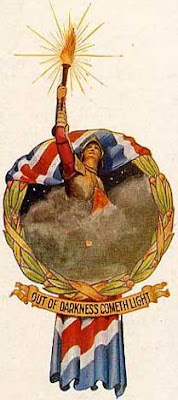By the time the West Ham Battalion arrived in France (December, 1915), Norman William Bellinger was regarded by everyone as a very good soldier and had been appointed Lance Corporal. He was also placed in charge of the medics under the direct command of Dr Alan Holthusen, the Medical Officer.
Holthusen was a locally born GP surgeon with a practise in Wanstead and his younger brother Len was also in the Hammers, living in Forest Gate and serving as the Signals Officer (and the current battalion snooker champion).
Norman Bellinger was 28 when he enlisted at the Hammers recruiting office in East Ham early in January 1915. He was one of those listed on the front page appeal for volunteers in the Stratford Express. Married on Christmas Day in 1909 to Lillian, and living with their young daughter at 33 Howard Road in Barking, Norman worked in a local india rubber factory as a labourer. He was short, yet very strong.
By April 27th 1916, the Hammers were in and around the modern-day town of Grenay in northern France. The German's launched one of the everyday hazards of trench life - mortar bombs, silent in flight and deadly on impact. During the attack, 38 year old Pte Joe Cooper was gravely injured. First on the scene was Norman Bellinger, who began wrapping Joe up in bandages. The two men then came under further mortar fire, which hit Norman himself in three places and no doubt made Joe's situation a whole lot worse.
Gilbert Rogers, 1919
With further brave assistance from the other stretcher bearers, the two wounded men were brought in. Norman had made every effort to save the badly injured Cooper despite bleeding heavily from his own wounds. Sadly, Joe didn't survive and wouldn't return to his native Limehouse. Today he's buried in the Loos British cemetery.
Norman recovered enough to continue exhibiting incredible bravery. Less than a fortnight later he dashed out, still patched up, to assist L/Cpl Jimmy Dutton from Plaistow who had been hit in a very similar attack. Norman picked him up and carried him back but he was already dead. For this action, he was one of the earliest men in the war to be awarded the Military Medal.
On June 1st, when the Germans blew three huge mines right on the Hammers front, Norman was one of the stretcher bearers picking up shattered men from the moonscape battlefield while under artillery fire. The wounded were all taken to Dr Holthusen's aid tent which that night practically became the Advanced dressing Station for the whole Brigade during the German attack.
Holthusen treated over 90 men from three different Regiments that night but they couldn't be moved out to the proper care they urgently required as the shelling on their positions was "intense". By the morning, as the shelling lessened, Norman Bellinger was transferring them on to lorries and off to hospital.
At the end of July, the West Ham Battalion were on the Somme and engaged in blocking the almost suicidal counter-attacks being made by the Germans against Deville Wood. 'The Devil's Wood', as it was known by the Tommys, was a desperately hellish place to be. Many Hammers were killed over their few days in the frontline, not many have known graves. Those that do were brought in by Norman and his stretcher bearers. Norman was seen to be tireless. He didn't care about sleeping, he didn't care about eating. He simply cared about getting those men off that horrendous battlefield. We'll never know how many men he saved or who today have a known grave thanks to him and others, but Norman's actions were enough for him to be awarded the Distinguished Conduct Medal.
Gilbert Rogers
When Colonel Papillon had his breakdown from shell shock at the end of the Somme Summer of 1916, it was Bellinger who personally led him home and back to his wife at Catsfield Place in Sussex. Norman then had an extended leave to recover himself before he transferred over to the Labour Corps. By Armistace Day, Norman Bellinger was classed as 50% disabled from his wounds and went home to Barking, in a new house at 28 Shaftesbury Road. He died in early 1963 having lived to be 76 years old.
Another of the Hammers stretcher bearers was Charlie Gladding. He was one of a number of men who lived in Tidal Basin, under the shadows of the world renowned Thames Ironworks. A large group of men from these streets joined the West Ham Battalion and among them was 22 year old Charlie who lived with his new teenage wife in Alice Street.
He worked closely with Norman Bellinger in rescuing those lads mown down on the battlefield, but by the end of Summer 1916 after their tour on the Somme, Charlie Gladding's spirit broke. Like so many men, he suffered a nervous breakdown. Sent home to his wife, he eventually recovered, and was then posted to the Labour Corps, serving overseas in Salonika. Sadly, it was here that he caught pneumonia in September 1918, just a few months before the end of the war, and died.
Sadly, I've not yet found a photo of these brave men. But I cant help admiring Norman Bellinger's bravery, as Joe Cooper was my Gt-Grandfather...


































